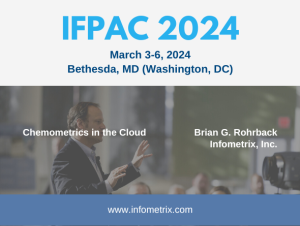 Venue:
Venue:
March 3-6, 2024
Bethesda North Marriott Hotel and Conference Center
Presented by:
Brian Rohrback, Ph.D., MBA, President, Infometrix, Inc.
Abstract:
In the spirit of automation, there are cloud-based tools from both the chemometrics and the general statistics realms that can be applied to simplify the work involved in optimizing a calibration. Robust statistical techniques require some set-up of parameters, but once established for an application, they are often usable in every other instance of that application. The result is a one-pass automated means of selecting optimal samples for a calibration problem and, in turn, simplifies and automates the assignment of model rank. In the end case, this means that a spectrometer can essentially become an appliance; take it out of the box, plug it in, and enjoy. The capability exists to have a spectrometer self-tune and adapt to a specific application, then keep the spectrometer in appropriate calibration completely through closed-loop control. Automation of best practices needs to include how to match laboratory reference data to spectral data, an unbiased approach to selecting validation samples, an optimal mechanism for model construction, establishing standards for quality reports, tracking model performance over time, handling process or ingredient transitions, and much more.
Register at www.IFPACglobal.org/attendee-registration.


